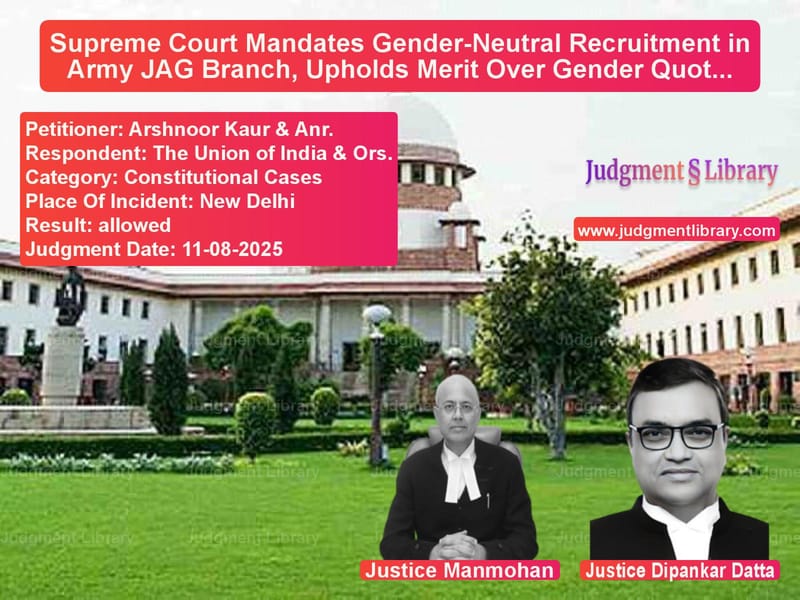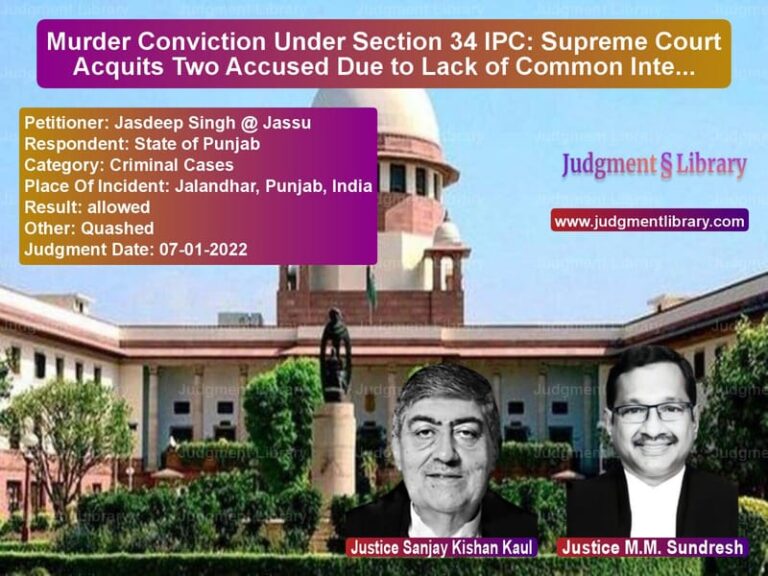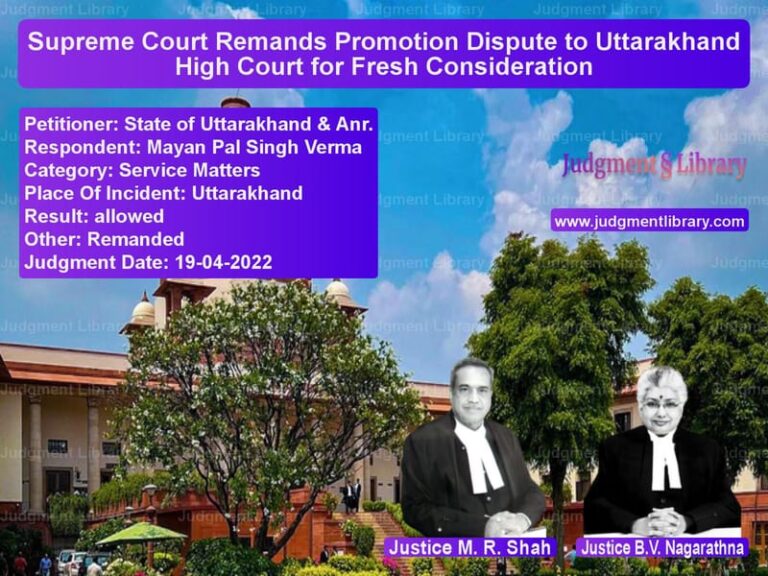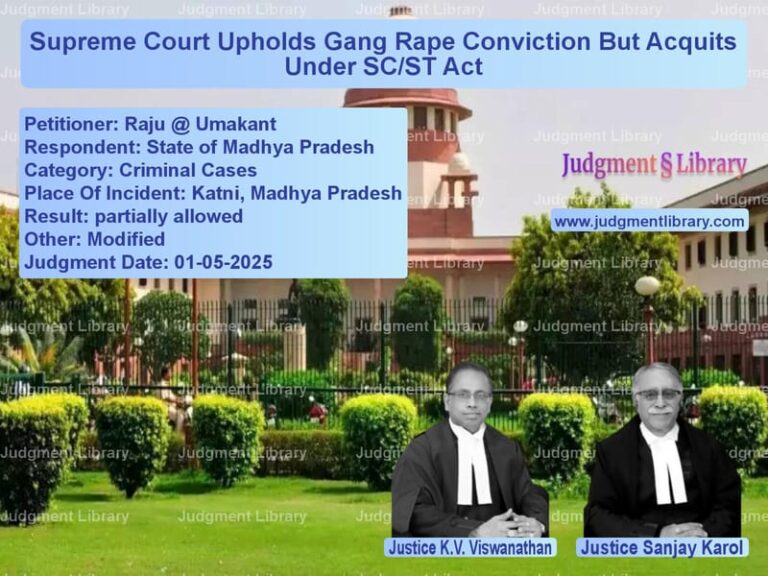Supreme Court Mandates Gender-Neutral Recruitment in Army JAG Branch, Upholds Merit Over Gender Quotas
In a landmark judgment that reaffirms the constitutional commitment to equality, the Supreme Court of India has delivered a powerful verdict addressing gender discrimination in the recruitment process for the Indian Army’s Judge Advocate General (JAG) branch. The case, which pitted two highly meritorious women candidates against the Union of India, centered on a fundamental question: can the government restrict the number of women inducted into armed forces branches where they are otherwise eligible to serve?
The dispute began when Arshnoor Kaur and Astha Tyagi, who secured the fourth and fifth ranks respectively in the women’s merit list for the JAG 31st Course, found themselves excluded from selection despite having higher marks than male candidates who were selected. The recruitment notification had specified only three vacancies for women compared to six for men, creating a scenario where less meritorious male candidates were selected over more qualified female candidates.
The Core Legal Question
The Supreme Court framed the primary issue succinctly: “whether after allowing induction of women in a particular corp or branch under Section 12 of the Army Act, 1950, can the Respondents by way of a policy and/or administrative instruction restrict the number of women candidates joining the said branch.”
The Petitioners’ Arguments
Mr. Gopal Sankaranarayanan, learned senior counsel for the petitioners, argued compellingly that the selection criteria for male and female candidates in the JAG branch were essentially identical. He emphasized that “the Service Selection Board (‘SSB’) procedure for male and female candidates is identical in content, structure and evaluation, including the fifteen (15) Officer Like Qualities.”
The petitioners pointed to the Ministry of Defence’s own press release from March 17, 2023, which stated unequivocally: “Employment in Indian Armed Forces is gender neutral. There is no distinction in the deployment and working conditions of male and female soldiers in the arms and services in which they serve.” This admission significantly undermined the government’s subsequent arguments for gender-based restrictions.
Citing constitutional provisions, the petitioners argued that “reserving additional seats for men in any public examination is not permissible and violative of Articles 14, 15 and 16 of the Constitution.” They relied on the established legal principle that “seats can only be reserved for women in view of Article 15(3). The other seats must be kept unreserved and filled up exclusively through merit.”
The Government’s Defense
The Union of India, represented by Ms. Aishwarya Bhati, learned Additional Solicitor General, mounted a multi-pronged defense. She argued that “maintenance of defence forces is a sovereign function and it is up to the Service Headquarters to decide the induction of Women Officers, including the ‘extent of induction’, so as to ensure that fighting efficiency, combat effectiveness and functionality of Armed Forces are maintained.”
The government contended that “all JAG Officers are combatants and there is a likelihood of all of them being deployed in combat,” and that “determination of vacancies is based on war time requirement to maintain optimal functional and operational need and thus, the same is gender-specific and not ‘gender-neutral’.”
Significantly, the government revealed that from 2024 onwards, a new policy would implement a 50:50 ratio for men and women in the JAG branch, moving from the previous 70:30 ratio. However, this still fell short of the true gender neutrality the petitioners sought.
The Court’s Reasoning
The Supreme Court’s judgment, authored by Justice Manmohan with Justice Dipankar Datta, delivered a comprehensive constitutional analysis that systematically dismantled the government’s arguments.
On the crucial question of whether the government could restrict women’s induction after permitting their entry, the Court was unequivocal: “once the Army permits women officers to join any corps, department or branch forming a part of the regular Army, it cannot impose an additional restriction with regard to ‘extent of induction’ of women officers in the said corps, department or branch—as Section 12 of the Army Act, 1950 does not empower it do so.”
The Court emphasized the constitutional framework, noting that “Articles 14, 15 and 16 of the Indian Constitution form a string of constitutional rights which firmly guarantee the right to equality.” While acknowledging that Article 33 allows Parliament to modify fundamental rights for armed forces, the Court stressed that “any restrictions on the Fundamental Rights must be found in the Army Act, 1950 itself.”
The judgment made a crucial distinction between gender equality and gender neutrality: “when an employer hires the same number of men and women, it would be deemed to be following the policy of ‘gender-equality’; on the other hand, if the employer hires the best candidate for the job regardless of gender/sex, it would be deemed to be following the policy of ‘gender-neutrality’.”
Addressing Indirect Discrimination
Perhaps the most significant aspect of the judgment was its recognition of indirect discrimination. The Court observed that “the practice of fixing a ceiling limit to recruitment of female candidates has the effect of perpetuating the status quo, which has been historically discriminatory to women candidates.”
The evidence was stark: “Respondent No.3 though placed at Serial No.6 in the mens merit list has obtained less marks than the female candidate placed at Serial No.10 in the female’s merit list. Accordingly, despite their performance, the meritorious women candidates are not being selected only due to their gender.”
The Court powerfully noted that “the result of such practice is confinement of women candidates, irrespective of their performance/merit, in their gendered category, thereby being destructive of not just the Constitutional scheme under Articles 15 and 16 as noted hereinabove, but also of the concept of ‘gender-neutrality’ and ‘merit’.”
Rejecting Stereotypes and Outdated Notions
The judgment strongly rejected gender stereotypes that have long been used to justify discrimination in armed forces recruitment. Quoting from its earlier Babita Puniya judgment, the Court reiterated that “The submissions advanced in the note tendered to this Court are based on sex stereotypes premised on assumptions about socially ascribed roles of gender which discriminate against women… Reliance on the ‘inherent physiological differences between men and women’ rests in a deeply entrenched stereotypical and constitutionally flawed notion that women are the ‘weaker’ sex and may not undertake tasks that are ‘too arduous’ for them.”
The Court noted the progressive changes already implemented: “Field parity has already been institutionalised.” It pointed to examples of women officers excelling in challenging roles, asking rhetorically: “why women officers in times of emergency cannot be deployed for counter-insurgency or in counter-terror forces or attached to Infantry/Artillery Units” when women like Captain Shiva Chouhan have served at Siachen Glacier, the world’s highest battlefield.
The Way Forward
The Supreme Court directed that henceforth, “Union of India shall recruit the most meritorious candidates in JAG branch irrespective of their sex/gender as the primary job of this branch is to give legal advice and conduct cases, but to ‘correct the past’ and to ‘compensate the women for their previous non-enrolment’, the Union of India shall allocate not less than 50% of the vacancies to women candidates.”
The Court mandated the preparation of a common merit list for all JAG candidates and directed that “the merit list [be made] public as well as the marks obtained by all candidates participating in the selection process.”
In a powerful concluding observation, the Court noted that “it is not imposing its own views or predilection on the Army but is implementing the Constitution and the mandate of law.” However, it agreed with the view that “‘no nation can be secure, when half of its population (i.e. its women force) is held back’.”
This judgment represents a significant step forward in the ongoing journey toward gender equality in India’s armed forces. By prioritizing merit over gender and constitutional principles over administrative convenience, the Supreme Court has reaffirmed that true equality means giving everyone an equal opportunity to compete and succeed based on their abilities, not their gender.
Petitioner Name: Arshnoor Kaur & Anr..Respondent Name: The Union of India & Ors..Judgment By: Justice Manmohan, Justice Dipankar Datta.Place Of Incident: New Delhi.Judgment Date: 11-08-2025.Result: allowed.
Don’t miss out on the full details! Download the complete judgment in PDF format below and gain valuable insights instantly!
Download Judgment: arshnoor-kaur-&-anr.-vs-the-union-of-india-&-supreme-court-of-india-judgment-dated-11-08-2025.pdf
Directly Download Judgment: Directly download this Judgment
See all petitions in Fundamental Rights
See all petitions in Constitution Interpretation
See all petitions in Public Interest Litigation
See all petitions in Employment Disputes
See all petitions in Recruitment Policies
See all petitions in Judgment by Manmohan
See all petitions in Judgment by Dipankar Datta
See all petitions in allowed
See all petitions in supreme court of India judgments August 2025
See all petitions in 2025 judgments
See all posts in Constitutional Cases Category
See all allowed petitions in Constitutional Cases Category
See all Dismissed petitions in Constitutional Cases Category
See all partially allowed petitions in Constitutional Cases Category







